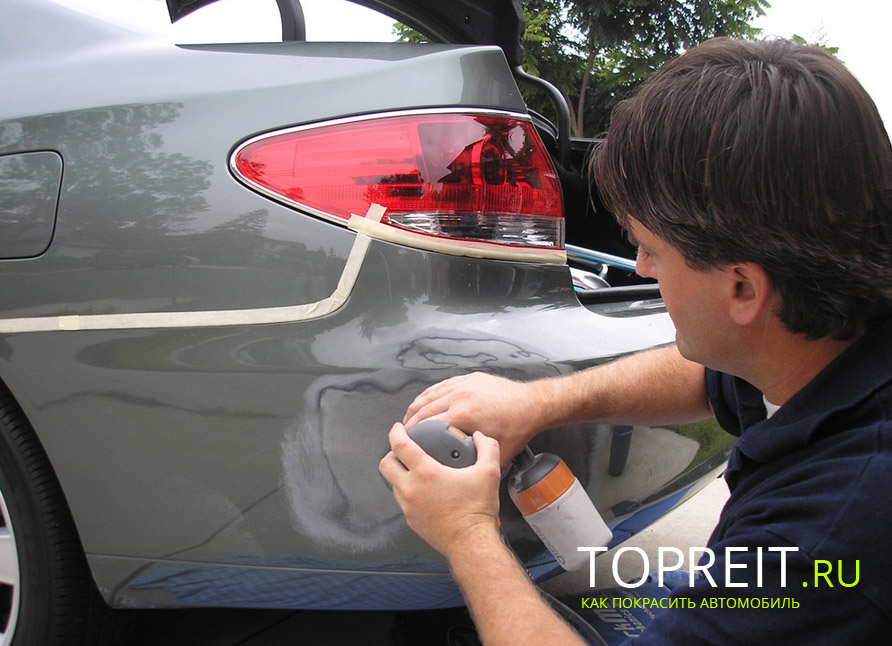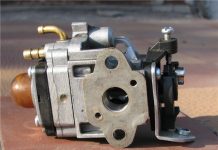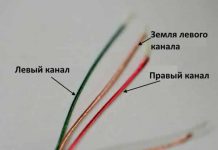In detail: a quick do-it-yourself bumper repair from a real master for the site my.housecope.com.
Today we will consider such an unusual case when a friend, taking a car for a ride, accidentally damaged the bumper. The situation is complicated by the fact that in the same place the bumper had already been damaged and could be repaired. But the main difficulty lies in the fact that the car is already on sale, or rather, there is even a client who is ready to purchase it, and then such an annoyance happened.
The owner of the car, of course, says that everything is fine with it and even plans to sell it in a few hours (about 3 or 4). Therefore, car repairs will need to be done quickly and, more importantly, with high quality.
To begin with, we take a typewriter, paper 120 or 80 and proceed to clean all the edges of the plastic, where later we will need to solder them.
Using a typewriter, we will need to clean off all the places where cracks are found.
After we go through the car, the bumper will look like this.
You need to go through, leaving about half a centimeter to the plastic, so that, as a result, you can solder everything.
It is important to watch to fill in the paint that is cracked and can peel off.
In addition, you will need to securely fix the bumper so that nothing cracks after soldering and puttying.
Spike, after, you need to securely combine everything, put a few special tacks so that everything stays on and looks good and even.
Next, we put a few tacks, then solder and put the grid in the most unsafe places where there may be a gap.
After soldering, we get a fairly impressive result. Follow the link to see and read in detail how to solder a plastic bumper.
| Video (click to play). |
Once again, you will need to use the machine and process the seam, as well as unsafe (in which a gap is possible) places.
Further, when the damage site is pre-treated with a machine, we will use P240 sandpaper, which we will wipe about a centimeter further from the seam and damage sites. These will be the boundaries of the area on which we will apply putty.
It should be noted that it is important to wipe the glossy places, which are shown below in the photo, where there are gaps.
Upon completion of processing the area around the seam with 240 paper, we use ambralon and rub our plastic carefully and slowly.
Our main task at this stage will be to get rid of the raised tendrils of plastic, which, even after they are covered with a primer, can be visible.
The car should look like this.
It is necessary that the plastic in those places where it was soldered had a matte color. In this case, the putty will stick to it tightly.
After that, you need to degrease the repair site, prepare the putty and apply it to the bumper.
This is what the first patch should look like.
The main thing, at the same time, is to grab all the top points.
For processing, you need to walk the machine.
Next, you need to use P150 and P240 paper to even out some of the bumps that may remain, and then you will have to apply putty again.
We spent about an hour and a half on this. It remains now to apply another overlay to finally align everything and give a good look to the entire bumper.
Now you need to close up some small areas, after which you can move on to the primer.
After we apply putty for the third time and round the edges, we can go directly to the priming process.
The bumper will look like this after we sand it with P240 and P320 paper.
It will be necessary to degrease the place of repair, where necessary - to glue it and then you can apply a primer.
The bumper will look like this after we cover it with a layer of primer. In appearance - quite evenly, there are even very pleasant roundness.
After that, it is necessary to wait until the primer dries up and sand the damaged area with P600 and P1200 paper and cover it with transitional paint.
In the fourth hour of work, we will cover with paper the nearby areas of the places where we will paint.
Nothing needs to be removed, the details are left in their places. Next, we need to apply metallic and varnish.
Varnish should be applied at a lower pressure so as not to splatter the entire machine.
Then you will need light pressure, only air, to level the coating.
During the repair process, everything was soldered, puttied, primed, painted and varnished at the end. The transition was hidden behind a number and a pipe.
Often in the road stream you can meet a car with a cracked or deformed buffer. What can you do, no one is immune from an unsuccessful parking or a light accident. However, this is not a reason to continue to drive a car that has lost its "brilliant" appearance - there is practical experience in restoring the original state of this element.
External plastic structural elements are mainly made of thermoplastic plastics. The technology for the restoration of such products is based on welding, which allows you to get rid of through cracks and even recreate broken fasteners. Actually, the procedure is not much more complicated than preparing and spray paint damaged section of the car body.
Some motorists assure us that we repair the bumper with our own hands using metal brackets. But an experienced car owner knows that similar things are treated with similar ones, that is, repair plastic rods are used for soldering. Their composition, color and profile are different, the desired rod is selected according to the marking on the buffer.
Making the right choice means guaranteeing a quality repair, because the mismatch of materials will significantly shorten the life of the automotive element. To find out what a cracked bumper is made of, just carefully examine the inside of the part. Depending on the marking, the following conclusions are drawn:
- PP - polypropylene base.
- ABS (GF, PAG 6) are hard plastics.
- PUR - polyurethane.
Plastic welding requires high temperatures, for example, 400-450°C is suitable for propylene, and 500°C is indispensable for the restoration of an ABS structure. Many car owners will learn how to repair a bumper with their own hands in a video where craftsmen use an ordinary 100 W soldering iron.
You can also restore a damaged part using pieces from a bumper with a similar marking. They are cut into strips 8 mm wide for PUR, and 4-5 mm for polypropylene.
Almost any breakdowns are treated by welding, even broken parts are reanimated. However, no one has canceled the economic feasibility of such work, because the restoration of numerous defects can hardly be called justified. The cost of a complete restoration and staining will cost more than a new buffer.
To perform repairs, you will need certain tools. It can be both ordinary household appliances and professional tools. The ideal kit includes the following:
- Orbital sander or sanding block.
- Grinding wheels of various grain sizes.
- Dremel type mini drill or drill.
- Clamps and rubber spatula.
- Soldering iron and building hair dryer.
- Metal tape.
Of the materials to restore a cracked buffer, you may need:
- Putty and primer.
- Brass mesh for crack reinforcement.
- A can of paint or a can of paint.
- Plastic repair rods of the desired configuration and composition.
The damaged part must be dismantled in order to eliminate, firstly, excessive stress in the area of cracks. Those who have already done such work will say that now we clean the bumper and only then repair it with our own hands.
Cracked parts fit together. For reliability, they are fixed with metal tape on the outside of the part. If the gaps are quite significant, then you will need clamps that clamp the edges of the cracks. Their number depends on the complexity of the repair.
When restoring parts on a PP base, reinforcing mesh is not used. The process begins with the fact that a nozzle with a nozzle with a diameter of 5-7 mm is installed on the hair dryer. Further work is carried out according to the points:
- On the inside of the buffer, along the junction of cracks, make a groove for the plastic rod with a Dremel mini-drill.
- Using a hair dryer, melt and place the repair rod into the prepared groove.
- Clean the front part of the bumper with an orbital sander with a P240 attachment and repeat the welding procedure in the same way as for the inside.
- Grind the cooled seam from the outside with a nozzle with the same grit P240, then remove dust from the surface.
- Smooth out irregularities with a special putty for plastic, try to make sure that the layer is minimal.
- Dilute the primer with a solvent 3:1 and apply two coats to the degreased surface. The drying time of the first layer is 15 minutes.
- Apply a developing layer in a contrasting color, followed by sanding with a wheel or sandpaper with a grit of P800 and P1000.
- Eliminate the detected defects with the help of nitro putty, followed by polishing with P1000 sandpaper.
- Remove dust with a damp cloth and degrease the part, after which paint plastic decorative paint with a border overlap of 50-100 mm. Apply paint in 3-4 layers with intermediate drying cycles.
Anyone who is interested in how to properly repair a bumper on a video with their own hands should take into account an important detail. 30-40 minutes after applying the last coat of paint, the part should be varnished. Thus, we get an impeccable appearance of the repaired part. Don't forget to follow a few simple rules:
- It is necessary to try to apply a minimum layer of putty.
- Maintain a temporary pause for the complete hardening of the putty layer.
- Treat the puttied place with a grinding wheel or sandpaper with a grit of P800, and after - P1000.
- It is desirable to apply a developing layer of primer.
In the case of a polyurethane buffer, the preparatory stage in the form of grooving is excluded. A reinforcing mesh of brass is superimposed on the crack; steel is not recommended for use, because it is susceptible to corrosion. As an alternative, staplers can be used every 10-20 mm. They are recessed into the body of the part across the seam, it is imperative to ensure that the bracket does not pass through the part.
Further, the repair technology does not differ from the restoration of a polypropylene part. Metal mesh or staplers must be recessed into the plastic layer. Only after that the seam is filled with repair plastic and soldered from the opposite side. Some important points of technology should be taken into account:
- You need to solder the mesh or staples carefully so as not to overheat the plastic, otherwise it may deform on the opposite side.
- For a complete do-it-yourself repair of a polyurethane bumper, the width of the reinforcing mesh should be 15-20 mm.
- It is better to press the mesh or staples with a flat object.
- If the legs of the staples pierce through the plastic, then they should be shortened with side cutters.
- For the convenience of working with metal elements, you can use tweezers.
- To prevent the new enamel from peeling off, it is necessary to sand the paint on the entire plane of the part.
The puttying stage and painting are carried out in the same way as described above - according to the traditional scheme. Repair work on the restoration of the buffer can be combined with car painting , so the consumption of materials will be more rational. It is important to determine in advance the feasibility of carrying out restoration work. If significant costs are visible in the future, then it is better to buy a new part.
The main function of the bumper is to protect the body from possible damage that may occur during the operation of the vehicle. In most cases, it is he who suffers from mechanical damage, the attack of small stones from the road surface and as a result of an accident.
The winter period is considered the most dangerous, since there is a high risk of an emergency on the road, which can cause damage to the bumper or split it. You can buy a new part, but such a purchase is quite expensive.
It will be much cheaper to repair the bumper with your own hands. This will not take much time and effort, and there will be no trace of a defect on the repaired part. Another reason why this part of the body may need urgent repair is its natural aging, which is inevitable even with careful operation of the car.
The bumper must be carefully prepared for painting, the technology for applying paint in this case has practically no differences with the technology for applying paintwork on a car body.
There are two types of bumper painting:
- Complete (you will need to dismantle the bumper, also the amount of materials used for work will be much greater than with local repairs).
- Local painting (in this case, it is not necessary to dismantle the bumper to complete the work).
Scratched bumper, what to do? This question is often asked by beginners and even experienced drivers when they find chips or other damage on this part of the body. You can give the car to the service station, or you can try to repair it yourself.
To begin with, it must be thoroughly washed and dried. This will help to assess the full scale of the damage and find ways to eliminate them. Types of bumper defects:
- Scratches in the form of a grid. Such defects are most easily eliminated using conventional polishing. Then the damaged area is treated with a special spray that improves adhesion and repainted.
- Dents and various chips. In this case, you can also repair the bumper with your own hands, for this you need to remove all dents with a special tool and putty.
- Broken bumper. Do-it-yourself repairs in this case are very difficult to carry out; in order to complete the work, it is necessary to collect all the pieces of the bumper.
For the correct execution of all work, you will need to purchase special materials and tools. In the process, you may need a soldering iron, a building hair dryer, a machine for polishing surfaces and circles for it (you can use a conventional electric drill with nozzles), sandpaper of different grain sizes, as well as consumables (special putty, primer, degreaser and paints and varnishes).
Before starting all repair work, it is better to dismantle the damaged bumper. In this case, it will be much more convenient to work and it is possible to avoid tension of materials at the defect site. The part must be thoroughly cleaned of accumulated dust and dirt by washing it in warm water using a special car shampoo.
After drying, the broken pieces must be glued and connected with adhesive tape. After that, you need to arm yourself with a soldering iron and carry out all work to restore the integrity of the bumper. To return the bumper to its original shape, all the fragments are soldered on the inside of it.
Since it is hidden from prying eyes, you can not worry about the aesthetic side when doing work. You need to solder the pieces very carefully, so that the seam is uniform along the entire length. In order for the repair to last for a long time, staples from a furniture stapler must be additionally soldered into the seam.
You need to choose them so that they do not pierce the bumper through and fit perfectly in length. It is better to use tweezers during the work to protect yourself from possible burns.
Staples should be placed perpendicular to the seam at a small distance from each other. All cracks in the bumper, which have just begun to appear, also need to be soldered so that during the operation of the car they do not develop into splits due to vibration. It is imperative to protect the staples from corrosion by covering them with heated plastic.
After all work is completed, the bumper should regain its original shape. Do-it-yourself bumper repair does not require any special skills, the main thing is to adhere to the technology for performing work.
After completing all the work to restore the integrity of the bumper, it is necessary to carefully grind the resulting seam. To do this, you can use a special grinder with circles of different abrasiveness or do all the work with sandpaper.
It is necessary to remove the old paintwork, remove the primer and level the surface. The seam after soldering also needs to be carefully polished, smoothing out all the bumps. No need to try to get a surface without a single flaw, since it is possible to thin the bumper and only further deform it.
After completion of the work, it is necessary to remove the dust accumulated on the surface by blowing the bumper with compressed air or treating it with a special napkin.
At the next stage, it is necessary to align all the defects with a special putty. Only dents and pits need to be leveled with a mixture, it is better to remove a layer of putty that is applied to a flat surface.
Allow sufficient time for each coat to dry (according to the instructions) before applying the next coat. After the putty has completely hardened, you can begin to level it with a grinder.
Work can be done with sandpaper, but this will require more time and effort. Also, the hard-to-reach places of the bumper are carefully treated with sandpaper. After that, the bumper is primed with a special two-component acrylic primer.
You need to apply it in a thin even layer to avoid smudges. Be sure to carefully treat problem areas and allow the previous layer to dry. You need to dry the soil for at least a day, you can speed up the process using a special infrared heater.
The grinding procedure begins only after the drying process is completed and is carried out in the same way as the previous stages. Before starting the procedure, it is imperative to use a developing powder to identify possible flaws that remained after the previous stage of the repair.
How to paint the bumper yourself? After finishing, the surface of the bumper is cleaned of dust and degreased. After that, you can start applying paint.
The paint color selection procedure needs to be given a lot of attention so that the subsequently repaired bumper does not differ in shade from the rest of the body paintwork. Therefore, it is better to contact the specialists of the service station, who will carry out tinting on special equipment.
This procedure is quite expensive, but it guarantees a 100% accurate selection of the desired shade of paint. Before starting work, it is better to try spraying paint on an old unwanted body part to check its quality and shade.
Before painting, it is necessary to thoroughly degrease the surface to ensure better adhesion of the paintwork and the base.However, this must be done very carefully, since a large amount of anti-silicone can provoke soil soaking, and all preparatory work will need to be done again.
The paint is applied in several layers until the desired shade appears, and after the paint has completely dried, the bumper is polished. If it is necessary to paint over only local damage, then grouting and all preparatory work should be carried out only at the site of damage.
Then the entire part is varnished so that the repair site does not stand out. If a low-quality varnish was used in the work or it was applied incorrectly, various kinds of defects may appear, which are sometimes quite difficult to eliminate.
It is better to apply a paint and varnish coating in a room specially equipped for this with the help of a compressor and a spray gun. The paint is applied very carefully so that smudges and other defects do not form on the bumper. Before pouring paint into the spray gun, it must be carefully filtered using a special filter or using a regular nylon stocking. The spray gun should be located at a distance of at least 20-25 cm from the surface of the bumper.










